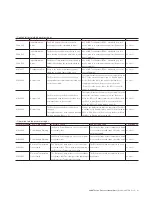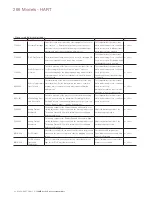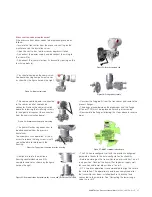
2600T Series Pressure transmitters |
OI/266/HART-EN Rev. D 73
Architecture description and principle of operation
The instrument consists of two main functional units:
– Primary unit
– Secondary unit
The pressure transducer unit includes the process interface, the sensor and the front-end electronics; the Secondary Unit
includes the electronics, the terminal block and the housing. The two units are mechanically coupled by a threaded joint.
Principle of operation
The principle of operation is as follows. In the primary unit the process fluid ( liquid, gas or vapour ) exerts pressure on to the
sensor via flexible, corrosion-resistant isolating diaphragms and capillary tubing containing the fill fluid.
As the sensor detects the pressure changes, it simultaneously produces variations of the primary physical value depending on
the sensor technology (capacitive, inductive or piezoresistive). The signal is then converted in the front-end electronics in a digital
form and the raw values are computed by a microcontroller to a precise primary output linearization, compensating for the
combined effects of sensor non linearity, of static pressure and temperature changes on the basis of the “mapped” parameters
calculate in the manufacturing process and stored in the memory of the Front End electronics. Calculations follow independent
flows and they are compared in the microcontroller in order to validate the output pressure signal. If a difference between the two
measurements is detected the analog output is driven to a safety condition. The measured values and the sensor parameters are
transferred via a standard serial digital communication to the secondary unit where the communication board is fitted.
The output data value is converted into a pulse-width signal that is filtered and that activates the 4-20 mA transmitter.
The bi-directional, digital communication using the standard “HART” protocol is implemented as part of this unit. Internal
diagnostics algorithms are implemented to check correctness and validity of all processing variables and the correct working of
memories. The output stage is also checked by reading back the analog output signal and by reading the power supply voltage.
The feedback loop is obtained by an additional A/D converter put at the end of the output stage, which translates the 4-20 mA
signal into a digital form suitable to be compared by the microcontroller.
Commissioning and configuration issues
The transmitter is considered in safety condition (normal operating mode) when the write protect switch placed outside the
transmitter housing below the metallic nameplate is in Write Protect. In that condition all kind of configurations of the device are
disabled.
Operating mode enabling and disabling
Operating mode can be enabled/disabled depending on the switch position. It is also possible to put the device in write protect
condition by a dedicated HART command. In any case the switch position has the priority on the software command.
Warning
After any configuration operation, the transmitter must be put in operating mode
Proof tests
Safe undetected faults could occur during the operation of the transmitters. These failures do not affect the transmitter operations.
To maintain the claimed Safety Integrity Level (SIL 2) a proof test procedure is requested every 10 years.
The proof tests consist in the following operations:
– Switch off the device.
– Assure that the Write Protect Mode switch is in Write Protect condition.
– Power-on the transmitter: the transmitter performs automatically a self-test that consists in the operations below:
ROM test
RAM test
Test of the analog output stage and of the feedback A/D converter
Test of the power supply voltage
Non volatile memory test
– Apply pressure up to 50% of the calibrated range and check the output value. It shall be within the stated safety accuracy (2%
of sensor range).
Summary of Contents for 266 HART Series
Page 40: ...40 OI 266 HART EN Rev D 2600T Series Pressure transmitters 266 Models HART Device Set up ...
Page 41: ...2600T Series Pressure transmitters OI 266 HART EN Rev D 41 ...
Page 42: ...42 OI 266 HART EN Rev D 2600T Series Pressure transmitters 266 Models HART ...
Page 43: ...2600T Series Pressure transmitters OI 266 HART EN Rev D 43 ...
Page 44: ...44 OI 266 HART EN Rev D 2600T Series Pressure transmitters 266 Models HART Display ...
Page 45: ...2600T Series Pressure transmitters OI 266 HART EN Rev D 45 ...
Page 46: ...46 OI 266 HART EN Rev D 2600T Series Pressure transmitters 266 Models HART ...
Page 48: ...48 OI 266 HART EN Rev D 2600T Series Pressure transmitters 266 Models HART Calibrate ...
Page 49: ...2600T Series Pressure transmitters OI 266 HART EN Rev D 49 Totalizer ...
Page 50: ...50 OI 266 HART EN Rev D 2600T Series Pressure transmitters 266 Models HART ...
Page 51: ...2600T Series Pressure transmitters OI 266 HART EN Rev D 51 ...
Page 52: ...52 OI 266 HART EN Rev D 2600T Series Pressure transmitters 266 Models HART Diagnostics ...
Page 53: ...2600T Series Pressure transmitters OI 266 HART EN Rev D 53 Device Info ...
Page 54: ...54 OI 266 HART EN Rev D 2600T Series Pressure transmitters 266 Models HART Communication ...
Page 77: ...2600T Series Pressure transmitters OI 266 HART EN Rev D 77 ...
Page 78: ...78 OI 266 HART EN Rev D 2600T Series Pressure transmitters 266 Models HART ...
Page 79: ...2600T Series Pressure transmitters OI 266 HART EN Rev D 79 ...








































